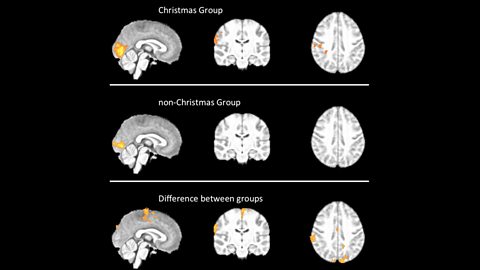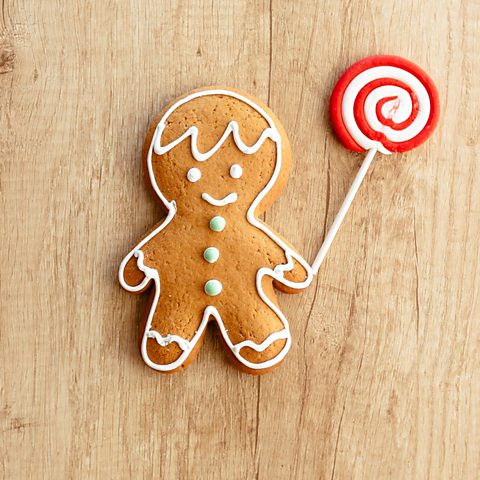Christmas can be intense and kind of emotional.
Whether itÔÇÖs that sinking feeling when you hear All I Want for Christmas for the 100th time or agonising about where you will spend Christmas day, thereÔÇÖs a lot going on. But it can also, of course, bring lots of joy and excitement.
In recent years, scientists have explored how Christmas affects our bodies and minds. Studies have shown that singing carols can relieve stress, and even found that Christmas Eve can be a peak time for heart attacks.
Bryan Haddock, a medical physicist at Copenhagen hospital, recently went in search of the Christmas spirit using brain imaging techniques in a light-hearted Yuletide study.

He was looking to see how people responded in different ways to Christmas images.
His team ran fMRI (Functional Magnetic Resonance Imaging) scans on a group of 26 people and found that the "Christmas Spirit" network had a significantly higher activation in people who celebrate Christmas with positive associations as opposed to people who have no Christmas traditions and neutral associations.
The group was asked questions about their experience of Christmas after the scans were taken. They were asked to fill out a questionnaire about their Christmas traditions, feelings associated with Christmas, how long they had lived in Denmark and ethnicity.

Mr Haddock concluded that ÔÇ£there is a Christmas spirit network in the human brain comprising several cortical areas. This network had a significantly higher activation in people who celebrate Christmas with positive associations as opposed to people who have no Christmas traditions and neutral associations.ÔÇØ
The scans showed that the brain was reacting to the Christmas images. However, the study did not conclude whether this was cause or effect - ie, whether this area lights up because you like Christmas, or you like Christmas because this area lights up.

Mr Haddock says, ÔÇ£The answer is that it could be either or both. We are catching the brain responding to the Christmas stimulus and the brain is fast. Several steps and subprocesses are being caught at once so it is possible one of the activated areas is recognising while another is creating a response.ÔÇØ
He also suggests that ÔÇ£although merry and intriguing, these findings should be interpreted with caution.ÔÇØ
So how did they find the Christmas Spirit network?
ÔÇ£In fMRI, you run a sequence of images and see if there is any stimulus in different parts of the brain.ÔÇØ
ÔÇ£The person lays in the scanner and we took a measurement every three seconds to monitor changes in blood oxygenation in the brain.

ÔÇ£We ran a sequence where we presented everyday images but then alternated it to a series of Christmas theme images, then back to regular images and repeated this cycle six times.ÔÇØ
ÔÇ£All the time, we were taking the same measurement looking to see which parts are changing in time with the images changing within that cycle.ÔÇØ
ÔÇ£We looked at fluctuations and we saw reactions (to the pictures being changed) in their visual cortex.ÔÇØ
 Image source, BMJ
Image source, BMJMr Haddock found that the part of the brain that lit up is also the part that is active when we have emotions shared with others - the primary motor cortex and pre-motor cortex. This part of the brain is also important for controlling body movement. Happy memories and pleasant behaviours are likely to activate the area.
However, Mr Haddock acknowledges there are limits to the study and that his colleagues in neuroscience might suggest that just because we can localise emotions in the brain, it doesnÔÇÖt contribute much to how we understand them.
Unfortunately this experiment canÔÇÖt provide definitive conclusions about the emotional impact of Christmas on the brain. However, he says, ÔÇ£itÔÇÖs not that far fetched to suggest a connection between these areas and why they we feel warm or happy when they light up.ÔÇØ

So does Christmas make Mr HaddockÔÇÖs brain light up?
ÔÇ£I still have knee-jerk responses to Christmas stimuli. The first time I hear certain songs or when I go get the tree, IÔÇÖm definitely getting some positive reactions.ÔÇØ
ÔÇ£I find it interesting to reflect on how we react at different stages of life. As a teenager I started to miss the excitement I felt when I was younger. Some of the things that really triggered me as a kid, the first time I saw a gingerbread, or practicing the Christmas play - all those things didnÔÇÖt excite me so much when I was a teenager. But now I have kids of my own and I have a different kind of excitement to experience it again with them.ÔÇØ

Six ingredients of the perfect Christmas blockbuster
Christmas movies: what makes them great?

Fed up of regular New Year's resolutions? Find out how to have a more mindful start to the new year.

Have yourself a merry, healthy Christmas
Need some support over the festive period? Check out our advice articles from experts and from young people who've been there and got through the other side.
